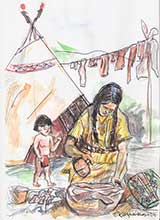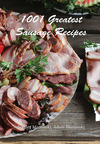Meats and Sausages
Pemmican
American Indians refined the process of making jerky further and created the perfect snack called “Pemmican”. Pemmican is a naturally produced high-energy bar that will last for years. There is a noted absence of pork in recipes because the pigs were not around yet. The first pigs came on board Spanish ships during Columbus' second trip in 1493 and were released to several Caribbean islands.
Hernando de Soto is “the father of the American pork industry.” He landed with America's first 13 pigs at Tampa Bay, Florida in 1539. Later, Hernando De Soto, during his expeditions, purposely left pigs from Florida to Texas so that there would be food sources for their return journeys. Native Americans reportedly became very fond of the taste of pork, resulting in some of the worst attacks on the de Soto expedition. By the late 1500s large wild populations of pigs were firmly established in the south of America.
Pemmican was made from thin slices of lean meat from large animals such as buffalo, deer, moose, and elk.- The sliced meat would be dried in the sun or over a fire.
- The dried meat was pounded with a wooden mallet, or ground and shredded between the stones.
- Ground wild berries were mixed with the pulverized meat. Often dried peppermint leaves or wild onions were added for flavor.
- Melted fat and bone marrow grease was added to the mixture.
The hot mixture was poured into large buffalo-hide bags (parfleches) and allowed to cool and harden. Indian women made parfleche cases from folded rawhide. Buffalo hide was most commonly used, but as those animals grew scarce, women used elk, moose and later cattle hides. Holes were burned in the hide for rawhide strings to be threaded through that were used to open and close the bag. Paint for decoration was obtained from European traders. The bags were filled with hot tallow (melted fat). They were generously greased along their seams to keep out air and moisture. As a result, the containers were sealed, and a huge vacuum bag was created which protected the product and kept it fresh for years. Before serving, the chunk of pemmican was chopped off with an axe and eaten raw or boiled. Originally pemmican was stored in the stomachs or large intestines of slaughtered animals. That was also a common practice in Europe and head cheese or blood sausage was stuffed that way. The Hudson Bay Company, which had a monopoly on the fur trade in Canada for a few hundred years, did a lot of trade with the Indians, and pemmican was one of the popular items.
| Original Pemmican - The Perfect Snack & Survival Food | ||
|---|---|---|
| Meat - 50% | Fat - 50% | Dried fruit & berries |
| Provided protein for sustaining muscles and body functions | Provided calories that were needed for energy | Provided vitamins which were so crucial in preventing scurvy |
How much dried fruit was added is a matter of speculation. It was probably added in the summer when widely available. European settlers started to add fruit and berries in larger quantities as flavoring. Pemmican became a perfect food for people on the move who needed high-caloric food or were traveling in wilderness areas where food was not readily available. Today’s health-conscious consumer might say that it contains 50% fat. Well, every time we buy a fresh sausage in a supermarket it also contains 50% of fat, as allowed by the law. The manufacturer is adding fat all the way up to the allowed amount because fat is much cheaper than lean meat. Take note that a commercially produced sausage contains many chemicals which were not added to pemmican. Pork fat is not the best choice for making pemmican due to its low melting point. Beef fat (tallow), when cooled resembles candle wax in color and consistency and makes better pemmican.
The Indian women made large bags known as "parfleches" from buffalo hides. The bags were lavishly painted with paint obtained from European traders. The parfleches were filled with hot pemmican and allowed to cool and harden. The seams were greased and topped with hot fat. As a result, the parfleches were sealed, and the product kept fresh for many years. Before serving, the chunk of pemmican was chopped off and eaten raw, boiled, or added to other food.

















